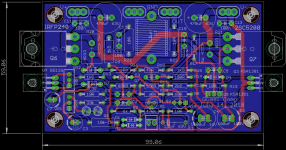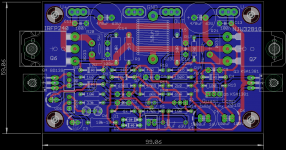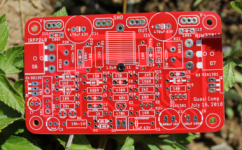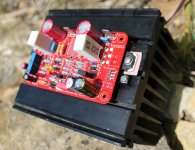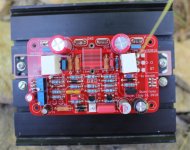Hi,
This is not a quasi complementary since it does not use a combination of MOSFET and Bipolar in the output stage
I have increased the size of the capacitors to 13 mm but I have to move a lot of things, however I have found that the 1 W resistor were far too big therefor I could reduce themDuring the modification I also modified some value based on the schematic drawn by DACZ (I hope that they are the last ones ?) and I found that the capacitor C7 had a wrong connection because the previous version didn't use a Zener diode ! By the way I have seen that it is possible to replace the Zener diode by a blue LED ? From my experience in tubes amplifier, it seems that LED are less noisier than Zener because they are used in the direct way and not reversed... What do you suggest ?
I have attached the schematic and the PCB for your comments.
Best regards,
Marc
7K2 in R13??
Hi EmeryBB, Hi Schillg11,
Thank you for finding the typing error on R13, the correct value is 1k2 on DACZ schematic
I have also reduced the size to 99 mm, but the mounting holes will be very close to the PCB edges
Finally I have made some cosmetic changes on the PCB to optimize some tracks and make the serigraph more readable... I hope this version will be OK to produce the boards ?
Best regards,
Marc
Thank you for finding the typing error on R13, the correct value is 1k2 on DACZ schematic
I have also reduced the size to 99 mm, but the mounting holes will be very close to the PCB edges
Finally I have made some cosmetic changes on the PCB to optimize some tracks and make the serigraph more readable... I hope this version will be OK to produce the boards ?
Best regards,
Marc
Attachments
Hi,
This is probably the last version before I send it to the PCB manufacturer, I have checked twice and make some tracks shorter, I hope I didn't forget anything, if you find some errors please tell me
I have a 300 VA transformer with 2 x 35 V AC output : http://www.farnell.com/datasheets/2...16.403529732.1531758856-1429063303.1527947097
This will give about 45 to 47 V DC after rectifier and 2 x 10'000 uF capacitors, do you think it will not be too much with a NJW3281G bipolar and a IRFP240 MOSFET and that I can use it for a stereo amplifier ?
Marc
This is probably the last version before I send it to the PCB manufacturer, I have checked twice and make some tracks shorter, I hope I didn't forget anything, if you find some errors please tell me
I have a 300 VA transformer with 2 x 35 V AC output : http://www.farnell.com/datasheets/2...16.403529732.1531758856-1429063303.1527947097
This will give about 45 to 47 V DC after rectifier and 2 x 10'000 uF capacitors, do you think it will not be too much with a NJW3281G bipolar and a IRFP240 MOSFET and that I can use it for a stereo amplifier ?
Marc
Attachments
Hi,
I have a 300 VA transformer with 2 x 35 V AC output : http://www.farnell.com/datasheets/2...16.403529732.1531758856-1429063303.1527947097
This will give about 45 to 47 V DC after rectifier and 2 x 10'000 uF capacitors, do you think it will not be too much with a NJW3281G bipolar and a IRFP240 MOSFET and that I can use it for a stereo amplifier ?
Marc
The voltage will be 49V to 52V DC after rectifier.
This NJW3281 & IRFP240 can work with no problem up to 85V
First power-up behaviour
I am just getting around to firing up the DACZ boards that I built several months ago. My usual procedure is to power circuits with my programmable bench PSU at this stage - using over-current protection to protect both the board and me. When I power the boards with 25VDC and a max of 3A, the over-current protection always kicks in instantly on both boards. I am using LED's in the circuit and both light momentarily. Is this expected behaviour?
I am just getting around to firing up the DACZ boards that I built several months ago. My usual procedure is to power circuits with my programmable bench PSU at this stage - using over-current protection to protect both the board and me. When I power the boards with 25VDC and a max of 3A, the over-current protection always kicks in instantly on both boards. I am using LED's in the circuit and both light momentarily. Is this expected behaviour?
For those in .au Jaycar has some 150+VA 70VAC CT EI transformers on sale for cents in the dollar. Current stock only
Online or in store only? Any chance you have a link?
In store only, see the AGGH threadOnline or in store only? Any chance you have a link?
Hi Marc.
I have used one emailed wire from TME- to forming coils arround a 10mm drill.
Transfer Multisort Elektronik - On-line Catalogue | 250 000 products offered.
Good luck for your firing up the amp.
Regards to all.
I have used one emailed wire from TME- to forming coils arround a 10mm drill.
Transfer Multisort Elektronik - On-line Catalogue | 250 000 products offered.
Good luck for your firing up the amp.
Regards to all.
Thanks for the tip Bangla, I see the picture of your coil on the post 1581 and it look very nice  I have also been impressed by the nice green coil of xrk971 on post 1470 and the coil of dirttracker73 on post 1743... When I try to make a coil it look like an old spring, may be this is because I have used a wire too small ?
I have also been impressed by the nice green coil of xrk971 on post 1470 and the coil of dirttracker73 on post 1743... When I try to make a coil it look like an old spring, may be this is because I have used a wire too small ?
Should I buy the one you recommended (1.32 mm) or should I buy the 1.5 mm as indicated somewhere in this thread ?
I am already a customer of TME and I like their Toroidy transformer that I have recommended for the EL34 Baby Huey amplifier... I like the fact that they have a very fast shipping service
Rgds
Marc
Should I buy the one you recommended (1.32 mm) or should I buy the 1.5 mm as indicated somewhere in this thread ?
I am already a customer of TME and I like their Toroidy transformer that I have recommended for the EL34 Baby Huey amplifier... I like the fact that they have a very fast shipping service
Rgds
Marc
In store only, see the AGGH thread
Thanks Thoglette, I managed to get my hands on 1.
94v 3A CT though so might be a bit too much for this particular project..
Higher values will "play safe" and make the design more tolerant of any compromised layout and so on. That was my reasonlng. It removes a potential source of trouble for you.
Yes, its workable although it may need need more refinement to get the very best from it.
A 390r gate resistor also makes less likely damage further back if mosfet's blow GS or GD.
- Home
- Amplifiers
- Solid State
- Very simple quasi complimentary MOSFET amplifier
